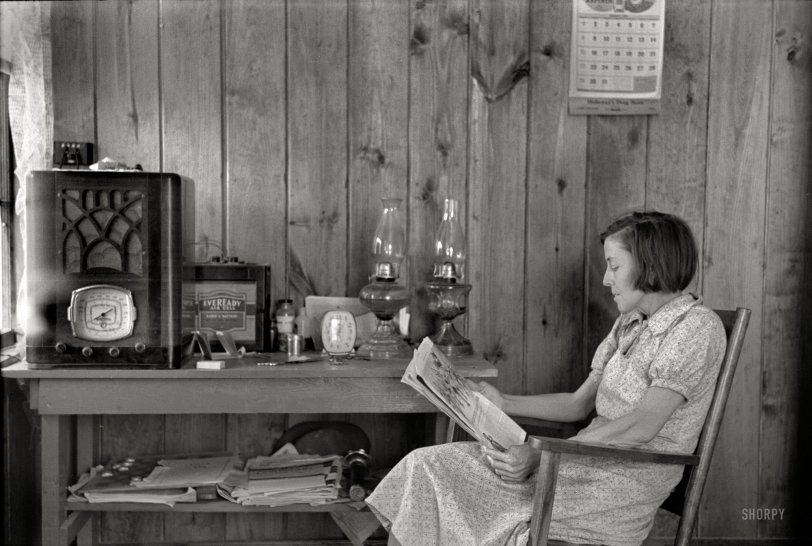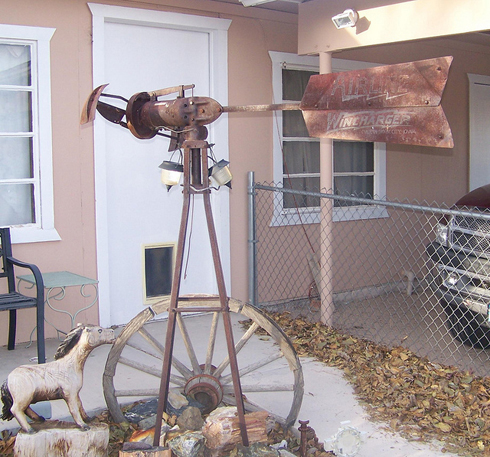


Framed or unframed, desk size to sofa size, printed by us in Arizona and Alabama since 2007. Explore now.
Shorpy is funded by you. Patreon contributors get an ad-free experience.
Learn more.

- If You’re Like Me, Never
- U.S.A.
- S&P
- 1940 Zenith radio model 6G601
- Quality goes in before the name goes on!
- Snazzy skirt
- Carbon Arc Lamps
- Illuminate us
- I remember it well
- I can't prove it
- Complicated then, forgotten now
- Bryan-Stevenson
- Skinny is as skinny does
- How do you rest in peace
- Riding the footboards
- Alas, hidden from view
- Baldwin Diesels
- Exclusive pump
- Bananas, Oysters and Smokey Joe
- Details, Details
- What's that building to the left of the tower?
- Coal Barges
- Bromo-Seltzer
- Inner harbor
- The Basin
- What a headache!
- Giant stepladder?
- Yeah, it was cold
- Love those coats
- Link & Pin Days Remnant
Print Emporium
Progressive Farmer: 1939

January 1939. "Housewife reading in living room. Chicot Farms, Arkansas." A peek behind the porch seen in the previous post. 35mm nitrate negative by Russell Lee for the Farm Security Administration. View full size.
Maybe for the "Gentlemen Farmers"
My parents talked about those generators for charging the radio batteries. Amid those depression years, Dad's family couldn't afford one. They mentioned once that they borrowed the battery out of my great uncle's car to listen to one much anticipated program (Grand Ol' Opry, one Saturday night, if I recall correctly).
By the time I came along, Mom's family had built a new farmhouse with electricity and all, but the old log-and-timber homestead quite like the one my dad grew up in remained intact and fully furnished, much as it had always been, so I was able to see where and how they'd lived in those days. It was very homey and comfortable even without all our conveniences. (The old dugout house where they'd lived even before the log home was still intact, too.) I have the old windup mantle clock that had sat on their mantle for more than 100 years now on mine. It still works properly.
Wind Generators
There were small wind generators available that were specifically for charging radio batteries. My neighbor has one for an Airline radio.

Conservation was the game
My parents, both of whom grew up on such farms, often talked about "radio days" and how they had to conserve their use of the radio so they could hear their most favored programs. Batteries were not rechargeable nor cheap so they tried to save their use as power diminished till they could get into town to get a new one. My dad told me how he and his neighbor (who later married my dad's sister, ultimately becoming my uncle) were both off to get batteries one Saturday. JL had set out in the model T and gotten bogged down firmly in the rural mud, but my dad had the good sense to make the trip by horse.
Off the grid
Hurricane lamps on the reading table, and a flashlight on the shelf below. Suspended halfway between 1850 and 1950, metaphorically speaking. By 1950 I bet the hurricane lamps were kept in the storm cellar just for emergencies. I wonder if they had a tractor yet?
Old Wave
If I remember correctly, "farm radios" powered by storage batteries were still in the Emerson Radio Catalogues well into the 1960s.
Rechargeable batteries?
Were the batteries rechargeable? If so, what did folks do, take them to town for recharging? If not, weren't batteries expensive?
Wireless
Rural electrification took a long time. Radios such as this that looked like ordinary AC sets yet operated on battery current are known as "farm sets" for exactly that reason. It's a Setchell-Carlson, model number TBD.
























On Shorpy:
Today’s Top 5